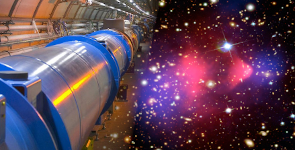Speaker
Description
Singlet-Triplet Fermionic Model ($\nu$STFM) with an extended fermion and Higgs sector is a well motivated model which explains both neutrino masses and dark matter (DM). Two of the triplet $\rho_{1,2}$ and singlet fermionic fields $N_{1,2}$ contribute to neutrino mass generation via seesaw mechanism, while, the remaining triplet $\rho_3$ and singlet $N_3$ fields are the constituents of the dark sector. The DM in this model can either be a WIMP or a FIMP candidate, depending on whether triplet $\rho$ or singlet $N$ state is the lightest $Z_2$ odd state. The Higgs sector consists of a real scalar triplet $\Delta$ and the SM Higgs doublet field $\phi_h$, with a non-zero mixing $\sin \alpha$ between the BSM neutral Higgs state $H_2$ and the physical SM Higgs boson $H_1$. In addition to the CP even neutral Higgs, the model also contains charged Higgs state $H^{\pm}$. The BSM Higgs states play a major role in determining the DM relic density. The mass of the states $\rho, N$ and $H_2$ are denoted as $M_{\rho}, M_N$ and $M_{H_2}$, respectively. We further consider the charged Higgs $H^{\pm}$ and $H_2$ share the same mass. We consider the model parameters in this following range and explore the DM production:
$10^{-12} \leq Y_{\rho\Delta} \leq 10^{-8}$,
$10^{-3} \leq \sin \alpha \leq 10^{-1}$,
300 GeV $\leq M_{\rho} \leq 1200 $ GeV,
$10^{-4}$ GeV $ \leq M_{N} \leq 100$ GeV,
125 GeV$ \leq M_{H_2} \leq 1000$ GeV
For the mass hierarchy $M_N < M_\rho$ and $M_{H_2}<M_\rho+M_N$, $N$ is the DM candidate. In the subsequent discussion, we consider $N$ as a FIMP candidate having feeble interactions with $\rho$ and $\Delta$. The interaction strength is governed by the respective Yukawa coupling $Y_{\rho \Delta} \sim \mathcal{O}(10^{-11})$ between $N$, $\rho$ and $\Delta$ states. The primary contribution to relic density comes from $\rho \to N H_{1,2}$, where both the thermal contribution and late decay contribution can be significant. We find that, for a BSM Higgs state $H_2$ having mass in between 200 GeV-1 TeV, as large as 60% contribution to relic density can also come from annihilation processes of the SM/BSM particles $A B \rightarrow \rho N$ mediated via $H_2$, where $A, B=W^{\pm},Z,\rho^{\pm}, H_{1,2}, H^{\pm}$ states. Such lighter BSM Higgs states can be constrained from a number of LHC searches and can have detectable signatures at the Run-3 of the LHC with the full integrated luminosity.
We consider three different types of LHC constraints, a) Higgs signal strength measurement, b) direct BSM Higgs searches, such as $p p \to H_2 \to W^+W^-, ZZ, H_1 H_1$, and c) SM Higgs to di-photon measurement. We find that the chosen parameter space is consistent with the above searches.
We further point out the possible signatures of the BSM CP even neutral Higgs and charged Higgs states at the LHC. The primary production for them is the Drell Yan production $ p p \to H^{+} H^{-}$ and $H_2 H^{\pm}$, as gluon fusion and VBF are suppressed due to a small $H_2-H_1$ mixing. In the mass range $200 {\rm GeV} < M_{H_2} < 375 {\rm GeV}$, the dominant decay mode is $H^{+} \rightarrow t \bar{b}$ while in the mass range $375 {\rm GeV} < M_{H_2} < 500 {\rm GeV}$, the dominant mode is $H^{+} \rightarrow W^{+} Z$. Therefore, for the lower mass range the signature from $H^{+}H^{-}$ production at LHC would be $4j+4b$ and $2l+4b$+MET. On the other hand for the mass range $375 {\rm GeV} < M_{H_2} < 500 {\rm GeV}$, the final states are $6l + \rm{MET}, 2l + \rm{MET},4j + 4l, 4j + \rm{MET}$. For $H_2$ the dominant decay mode is $W^{+}W^{-}$ in the entire mass range.Therefore, one can search for $pp \rightarrow H^{+}H_2$ in the following final states $6j+2b, 5l+$MET. The typical cross-section for 13.6 TeV LHC varies in between 60 fb-1 fb for the pair and associated production $p p \to H^{+}H^{-}, H_2 H^{\pm}$ in the mass range $M_{H_2}=M_{H^{\pm}} \sim 200 \rm{GeV}-500$ GeV. This leads to $\sigma \sim 10-0.1$ fb for $4j+4b$ final state, $3.2 -0.03$ fb for $2l+4b$+MET final state. Similar cross-section can also be obtained for the final states 4j + 4l, 4j + MET. The existing searches such as multi-jet+MET or multi-lepton+MET can be utilised to constrain this model. Another important characteristic of this model is the presence of $5l$ final states associated alongwith MET $p p \to H_2 H^{\pm} \to W^+ W^- W^{\pm} Z \to 5l+$MET. For lighter mass such as 200 GeV the cross-section is about 0.2 fb. However the presence of $5$ leptons may provide added benefit for background suppression at the LHC run-3.
